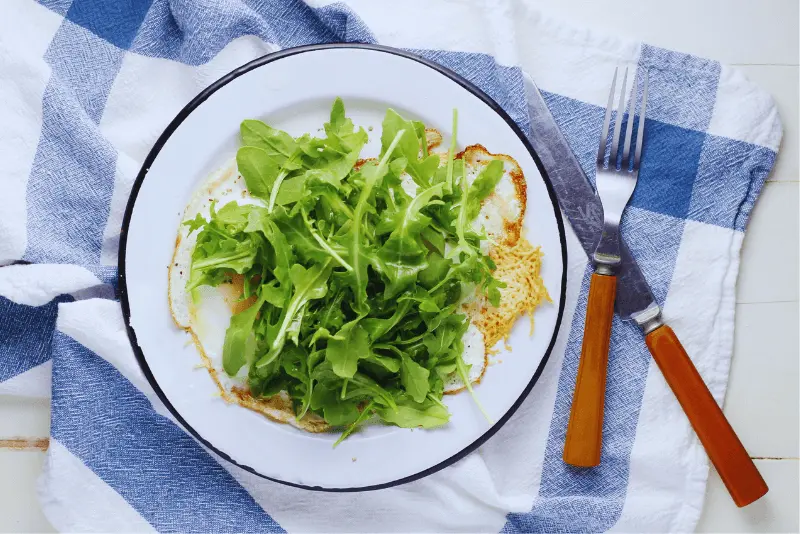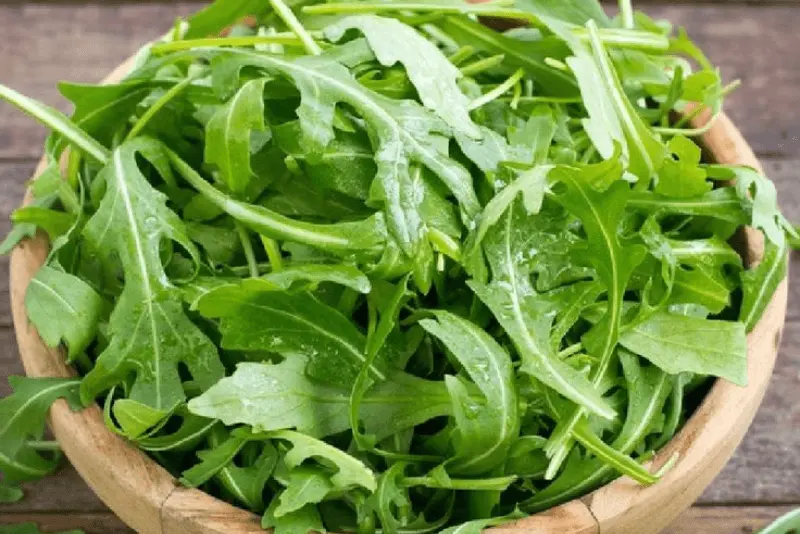Can Guinea Pigs Eat Arugula? Guinea pigs can enjoy arugula in moderation due to its rich nutrients but its higher calcium content requires careful feeding, offer them once or twice a week. The peppery leafy green is appreciated for its unique taste and texture, but guinea pigs might not like its distinct flavor. Be careful if your guinea pigs have bladder problems. A balanced mix of various vegetables is essential, and arugula should not be the sole vegetable. Owners should be mindful of the nutritional balance and frequency when incorporating arugula into their guinea pigs diet.
What Is Arugula?
Arugula is a leafy green vegetable with distinctive peppery flavor. Belonging to the Brassicaceae family, it shares similarities with cabbage and kale. Rich in vitamins and low in calories. Arugula is a nutritious addition to salads, sandwiches, and pizzas. It is a dark green leafy plant, and the leaves are bumpy and taste a bit bitter. People like using it in Mediterranean cooking. You can eat it fresh in salads or cook it. Sometimes, it is mixed with other greens to balance its strong taste. Vegetarians really like it and in different cooking styles it is called “rocket”. It is not expensive, and it has a tasty flavor.
Do You Know?
Arugula, also known as rocket, belongs to the Brassicaceae family, making it a cruciferous vegetable like broccoli and kale.
Can Guinea Pigs Eat Arugula?
Yes, guinea pigs can eat arugula in moderation as it provides essential minerals and vitamins. While it is a healthy treat and also contains calcium, it means it should not be a regular part of their diet. Some guinea pigs may not like arugula due to its peppery taste. Offering them in small amounts is recommended to avoid potential health risks associated with excessive consumption, particularly related to urinary problems. However, moderation is key when offering arugula into the diet of guinea pigs.
Guinea Pig’s Diet
Guinea Pigs Eat Arugula and require a herbivorous diet, with pellets and high quality hay like timothy fresh vegetables and hay forming the majority 80 to 90% of their daily Diet. However fresh leafy vegetables should be provided daily, while treats like fruits and grains can make up 5 to 10% of their diet on the days they are offered. Fresh vegetables are crucial for guinea pigs as they lack the ability to produce their own vitamin C. Arugula is a vegetable, that can contribute to their vitamin C intake. Guinea pigs also benefit from supplemental vitamin C through pills or drops. It is essential to ensure a varied and nutritious diet to meet their specific nutritional needs and keep them healthy and happy.
Nutritional Value of Arugula
Here we see 100 gram of Arugula contains Various Nutrients that are given in below table:
| Nutrient | Amount per 100g |
| Water | 91.71g |
| Energy | 25 kcal |
| Protein | 2.58 g |
| Total lipid (fat) | 0.66 g |
| Carbohydrates | 3.65 g |
| Fiber | 1.6 g |
| Sugar | 2.05 g |
| Calcium, ca | 160 mg |
| Iron, Fe | 1.46 mg |
| Magnesium, Mg | 47 mg |
| Phosphorus, P | 52 mg |
| Potassium, K | 369 mg |
| Vitamin A | 119 µg |
| Carotene | 1424 µg |
| Vitamin C | 15 mg |
| Vitamin B-6 | 0.073 mg |
| Fatty acids | 0.319 g |
| Lutein + zeaxanthin | 3555 µg |
Guinea Pigs Eat arugula and it contains many different nutrients in it as other vegetables contain Guinea pigs eat asparagus. Here are some common nutrients that arugula contains:

Health Benefits of Arugula for Guinea Pigs
Arugula, with its vibrant flavor and nutrient rich profile, offers numerous health advantages for guinea pigs. Incorporating this leafy green into their diet can contribute to their overall well being in several ways:
Digestive Health Support
Arugula is an excellent source of dietary fiber that promote healthy digestion in guinea pigs. The fiber content aids in preventing constipation and ensures smooth bowel movements to support optimal digestive function.
Essential Vitamins for Immunity
Arugula is a rich source of vitamins particularly vitamin A and vitamin K that plays a vital role to boost guinea pigs immune systems. Vitamin A acts as an antioxidant that protect against illnesses and free radical damage, while vitamin K supports bone health and faster wound healing.
Antioxidant and Anti Cancer Properties
Guinea pigs eat Arugula and it contains powerful antioxidants such as glucosinolates, which have been associated with anti cancer properties. These compounds target free radicals and help prevent oxidative stress that reduce the risk of chronic diseases, including certain types of cancer.
Bone and Muscles Health
The presence of minerals like magnesium in arugula contributes to healthy bones and muscles, including the crucial muscles of the heart. This is particularly significant for guinea pigs that may not tolerate excess calcium, providing an alternative for bone support.
Weight Management and Energy Boost
With a balanced mix of carbohydrates, fats, and proteins arugula supports guinea pigs nutritional needs without the risk of obesity. The plants that are low in sugar and fat contents along with no cholesterol ensures that guinea pigs receive the energy they require for daily activities.

Vision and Skin Improvement
Vitamin A in arugula contributes to better vision and supports healthy skin. The antioxidants present in arugula can minimize inflammation that enhance the overall condition of the skin and fur in guinea pigs.
Dental Health Benefits
Chewing on arugula leaves provides a natural way for guinea pigs to maintain their dental health. The fibrous texture of the leaves helps in wearing down their continuously growing teeth that prevent potential dental issues.
Variety for a Balanced Diet
Arugula adds variety to the guinea pigs diet that contribute to a well rounded and balanced nutritional intake. A diverse diet ensures that guinea pigs receive a spectrum of nutrients essential for their overall health.
Risks of Feeding Arugula to Your Guinea Pigs
Arugula is a nutritious option for guinea pigs that comes with potential risks that pet owners should be aware of. Understanding these risks is essential to providing a balanced and safe diet for your furry friends.
Calcium Overload
Bladder and Kidney Stones: Arugula is relatively high in calcium and excessive intake can lead to the formation of bladder and kidney stones in guinea pigs. These stones can result in discomfort urinary issues and may require veterinary intervention.
Digestive Distress
Cruciferous Nature: Being a cruciferous vegetable arugula may cause gas or stomach discomfort especially when introduced to a guinea pigs diet for the first time. This can lead to digestive issues such as bloating and gas.
Vitamin A Excess
Liver Problems: Arugula is rich in Vitamin A and an excess of this fat soluble vitamin can lead to liver problems over time. Care should be taken to avoid overconsumption as guinea pigs may store excess Vitamin A in their bodies.
Allergic Reactions
Potential Sensitivities: Like any new food there is a risk of allergic reactions to arugula. Introduce it gradually into your guinea pigs diet and monitor for signs of allergies such as itching, swelling or changes in behavior.

Digestive Upset
Fiber and Nutrient Overload: Arugula if given in excessive amounts can overwhelm a guinea pigs digestive system. This may result in stomach pains, diarrhea, abdominal discomfort, and bloating.
Preventive Measures
To mitigate these risks consider the following preventive measures:
- Moderation: Feed arugula in moderation to avoid excessive intake of calcium and other nutrients.
- Gradual Introduction: Introduce arugula slowly into your guinea pigs diet allowing their digestive system to adapt.
- Monitoring: Keep a close eye on your guinea pig for any signs of discomfort, digestive issues or allergic reactions after introducing arugula.
- Consult with a Veterinarian: If you have concerns or notice any adverse reactions, consult with a veterinarian for personalized advice on your guinea pigs dietary needs.
By understanding and managing these risks you can ensure that when arugula included in your guinea pigs diet it contributes to their overall well being without compromising their health.
Serving Size and Frequency of Arugula for Guinea Pigs
How often can guinea pigs eat arugula?
Guinea pigs can eat arugula, which is good for them. However arugula has a lot of calcium which is not good for them in excess. So, it is important not to give it too much. To avoid problems due to excessive calcium intake, it is best to give arugula only 1 to 2 times a week. Don’t give it every day wait a few days between servings to guinea pigs. This helps to control the amount of calcium. Even though vegetables are good for guinea pigs but moderation is key for good health. So, it is a good idea to give arugula one to three times a week and mix it with other vegetables for a well rounded diet.
By following these guidelines, you can keep guinea pigs healthy by providing good nutrition without causing problems.
How Much Arugula Can Guinea Pigs Eat?
We advise feeding each guinea pig a few leaves of arugula such as two larger or three smaller leaves. Ensure the arugula is fresh, raw and thoroughly washed with water before offering it to guinea pigs. To enhance the taste and control calcium intake consider mixing arugula with other leafy greens or vegetable leaves.
Combining various vegetables not only increases the serving size but also adds a neutral flavor to the tangy arugula taste. It is best to feed guinea pigs small amounts at a time to manage calcium levels as a high calcium diet can be harmful. Personally I blend arugula with low calcium vegetables like bell peppers, lettuce, tomatoes, cucumber, zucchini etc to maintain a balanced diet for my guinea pigs.

How to Prepare and Feed Arugula to Your Guinea Pig
Guinea pigs eat arugula, and it is health beneficial for them because it is a healthy and organic diet. Proper preparation of feeding arugula is crucial. By following these steps you can create a safe and enticing serving for your pet guinea pigs.
1. Choose Fresh Arugula Leaves
Choose bright green fresh leaves that don’t look rotten or too wilted. If you can pick organic arugula for better nutrition and fewer pesticides.
2. Give It a Good Wash
Give the arugula leaves a good wash under cool running water to eliminate any germs, dirt or residues. Even with organic produce thorough washing ensures your guinea pigs safety.
3. Serve Whole Leaves
Guinea pigs can safely enjoy the entire arugula plant including stems and leaves. Present them with whole leaves for a natural and enjoyable feeding experience promoting mental stimulation and natural foraging behavior.
4. Proper Storage
Put any extra arugula in the fridge and keep baby arugula in its bag and if you have bunches, use a plastic bag in the vegetable drawer. Try to use the arugula within three days to keep it fresh and tasty saving its good nutrients.
5. Avoid Washing Until Feeding
For the freshest leaves avoid washing them until right before giving them to your guinea pig. This keeps the leaves crisp and tasty that makes them more appealing to your pet.
Tip
If you are adding arugula to your guinea pigs meals, try making a vegetable salad from different veggies.
More Information About Arugula and Guinea Pigs
Can Guinea Pigs Eat Baby Arugula?
Yes, Guinea Pigs Eat baby Arugula also feeding baby arugula is completely safe and in fact they often prefer it over the mature leaves. Baby arugula is essentially the early harvest of regular arugula before the leaves fully develop. While it retains a similar nutritional profile to mature arugula the baby variety is often less bitter making it more appealing to guinea pigs.
Baby arugula contains the same amount of calcium as its older counterpart. Despite the peppery and zesty taste of mature arugula guinea pigs tend to enjoy the milder flavor and softer leaves of the baby variety. It is essential to offer baby arugula in moderation considering its rich vitamin and mineral content.
Can Guinea Pigs Eat Arugula Sprouts?
Guinea pigs eat arugula sprouts in moderation. Arugula microgreens, rich in calcium, Vitamins K and A, along with various essential nutrients that offers a milder taste compared to mature arugula leaves. Growing these sprouts in pots is an easy and rewarding indoor gardening project. Harvest ready in just 10 days arugula sprouts can be a delightful addition to your guinea pigs diet. Homegrown microgreens ensure a fresh and nutritious treat for your pets contributing to their overall well being.
Can Baby Guinea Pigs Eat Arugula?
Yes, baby guinea pigs can eat arugula in moderation. Arugula is a nutritious leafy green that provides essential vitamins and minerals including calcium that is crucial for growing guinea pigs. However due to the sensitive digestive systems of young guinea pigs it is recommended to introduce arugula gradually.
How to Introduce A New Food For The First Time
Guinea pigs eat arugula and when you introduce new food for the first time to your guinea pigs. Keep in mind you should be done gradually to avoid any potential digestive issues. Here is a step by step guide:
Research the Food:
- Understand the nutritional content of the new food item to ensure it is safe and suitable for your guinea pig.
- Check if there are any specific guidelines or restrictions for feeding that particular food to your pet guinea pig.
Start Small:
Begin by offering a very small amount of the new food. This allows you to observe your Guinea pig reaction and ensures they can tolerate the new food well.
Observe Their Response:
Watch your Guinea pig closely for any signs of allergies, digestive upset or adverse reactions. These signs may include changes in behavior, diarrhea or lethargy.
Gradual Increase:
If your Guinea pig tolerates the small amount without any issues gradually increase the quantity over several days. This slow introduction helps their digestive system to adjust food.
Monitor Health:
Continue monitoring your pets health and behavior as you increase the new food in their diet. If you notice any adverse reactions reduce or eliminate the new food.
Maintain a Balanced Diet:
Ensure that the new food complements their existing diet and does not replace essential elements like hay or specially formulated pellets.
Fresh and Safe:
Always provide fresh and clean food. Wash fruits and vegetables thoroughly to remove any pesticides or contaminants.
Consult Your Veterinarian:
If you have concerns or if your Guinea pig has a pre existing health condition consult with your veterinarian before introducing new foods.

Quick Facts About Arugula
Guinea pigs eat arugula and here are some facts about arugula:
- Arugula belongs to the Brassica family and is known for its nutrient density.
- The distinctive taste of arugula adds a peppery kick to salads and dishes.
- It contains vitamins A, C and K along with folate, calcium and potassium.
- Often harvested as microgreens that prized for their mild flavor.
- Associated with antioxidant properties and potential support for bone health.
- Used in salads, sandwiches, wraps, pasta dishes and as a pizza topping.
- Relatively easy to cultivate, thriving in cooler temperatures.
- Arugula scientifically identified as “Eruca sativa,” with origins in the Mediterranean region.
- Has a long history in Mediterranean cuisine and was traditionally used in Italian and Roman dishes.
- Its peppery taste balances well with milder greens in mixed salads.
- It is a low calorie vegetable that make it a favorable choice for those managing calorie intake.
Do Guinea Pigs Like Arugula?
Yes, guinea pigs generally like arugula for its taste and nutritional benefits. Introduce it gradually and ensure it’s fresh and clean as part of their balanced diet.
Can guinea pigs eat cooked arugula?
No, guinea pigs cannot eat cooked arugula. Offer them fresh raw arugula to ensure they get the necessary nutrients.
Can guinea pigs eat arugula stalks?
Yes, guinea pigs eat arugula stalks as well as arugula leaves and arugula stems but keep in mind offer them in moderation for their healthy life.
Is arugula healthy for guinea pigs?
Yes, arugula is generally healthy for guinea pigs when fed in moderation. It provides essential vitamins and minerals such as vitamins A, C and K along with calcium and other nutrients.
Conclusion
Guinea pigs eat arugula and it can be a delightful addition to their diet. This leafy green not only provides a unique peppery flavor that many guinea pigs enjoy but also delivers essential nutrients such as vitamins A, C and K as well as calcium. However moderation is a key with you start any new food to your guinea pig. Starting with small amounts and carefully monitoring their response ensures a smooth transition into incorporating arugula into their diet. Remember to serve fresh, washed arugula and always consider it as part of a well balanced diet alongside hay and guinea pig pellets. By doing this you can offer your furry friend a tasty and nutritious treat that contributes to their overall health and well being.







